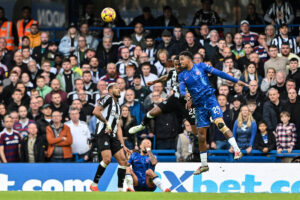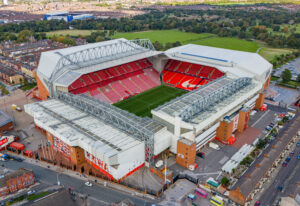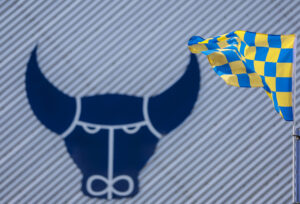It wasn’t Anfield ‘89, which was a once-in-an-eternity performance and result. Nevertheless, Arsenal’s performance in the first leg of the Carabao Cup semi-final was one of the Gunners’ finest displays at Liverpool’s ground since that historic night, especially after they went down to 10 men after less than half an hour when Granit Xhaka (whose name we now know for sure is the Albanian or Kosovan-Albanian for “Utter Liability”) was sent off yet again. In fact, it was so good that for older Arsenal fans it brought back memories of what might be called “Old School Arsenal”, a team and indeed a club that in its sheer, often unbeatable resilience was the complete opposite of the flaky, volatile Arsenal that has been seen so often over the last decade or more.
Young Gunners Evoke Memories of Old School Arsenal
A Brief History of “Boring, Boring Arsenal”
For many younger football fans, even many younger Arsenal fans, the idea that for much of the 20th century the Gunners were so synonymous with defensive stability and sheer “refuse to lose” attitude that they were often called “Boring, Boring Arsenal” must seem inconceivable, given how defensively porous and quite simply willing to lose Arsenal have been in recent years. And yet it’s true. In the decades before the introduction of three points for a win (which in England was in 1981) and even for a long time afterwards, “Arsenal” was almost a byword for defensive solidity. The great Herbert Chapman often instructed his teams in the late 1920s and 1930s to at least retain the one point that they started the game with before thinking of winning two points; Bertie Mee’s Double-winning side of 1971 was largely regarded by opposing teams and fans as simply a collection of defensive and midfield enforcers; and George Graham was so obsessed with having a solid rearguard that it was sometimes said his hobby was collecting centre-halves.
Initially under Arsène Wenger, much of that defensive prowess was retained. Wenger grafted the flair and invention of Vieira, Petit, Overmars and Anelka on to the famous back four (or five) of Adams, Bould, Dixon and Winterburn (and Keown) to create his own first Double-winning side in 1998. And even when those legendary defenders eventually retired, he found world-class replacements, either by developing them himself (Ashley Cole and Kolo Touré) or buying them in (Sol Campbell and Lauren).
Eventually, of course, the balance tipped too far the other way, as Wenger seemed to prize attacking invention and intent infinitely more highly than even basic defensive prowess, to the extent that in his last decade in charge at The Emirates the only defenders really worthy of the name were Laurent Koscielny and Nacho Monreal, and even they would only have been substitutes or squad players in George Graham’s sides or the early teams of Wenger. And when they both left Arsenal in the summer of 2019, the team’s defence was even further undermined, so much so that Unai Emery soon lost his job and his replacement, Mikel Arteta, largely struggled for his first two years in charge.
“Boring, Boring Arsenal” Once More?
Arsenal’s performance at Anfield in the Carabao Cup suggested that for the first time since the departure of Sol Campbell (shortly after Arsenal’s Champions League Final defeat to Barcelona in 2006), the Gunners might finally be starting to develop a defence worthy of the name and one that at least bears comparison with the great Arsenal backlines of the past. For one thing, after Xhaka’s red card there were almost as many centre-backs on the pitch – White, Gabriel, Holding and Chambers (even if Chambers was playing at right-back) – as there were in the George Graham era. For another, the entire team played with a collective will and intensity, covering for each other and – crucially – continuously communicating with each other, that bore, in every sense, the hallmarks of the Old Arsenal.
Of course there are caveats, most importantly the fact that Liverpool were playing without their two best players, Mo Salah and Sadio Mané, who are currently competing for their countries at the African Cup of Nations. And much of Arsenal’s good defensive work would have been undone if Takumi Minamino had taken advantage of the one clear goal-scoring chance that Liverpool created rather than wastefully blazing over the bar late on. However, as if often said (particularly by sportspeople), you create your own luck, and there was no doubt that Arsenal’s brilliantly efficient display and ‘thou shall not score’ attitude deserved at least a draw.
Can the Gunners Retain Such Defensive Strength?
The key question now is whether Arsenal can retain such defensive strength in the future, especially the immediate future, starting with the North London derby against Spurs this weekend.
Xhaka’s sending-off and subsequent two-game ban means that he will miss both the Spurs game and the second leg of the Carabao Cup semi-final against Liverpool at The Emirates next week. In one sense, that is no loss at all, because the Swiss midfielder is so consistently reckless on the field that it is almost better to start with 10 men rather than losing him halfway through a game, or earlier. In another sense, though, it may mean that Mikel Arteta has to deploy one of his centre-backs in central midfield alongside Albert Sambi Lokonga – perhaps Callum Chambers, who has played in that position before, albeit while on loan at Fulham rather than for Arsenal.
That does prompt the question of why Ainsley Maitland Niles, a natural defensive midfielder, was allowed to go on loan to Roma, especially when Arteta knew that, like Liverpool’s Salah and Mané, Thomas Partey would be absent from English domestic football for at least a month while representing Ghana in Cameroon. On the positive side, however, at Anfield last night Arteta’s Arsenal finally showed that they might just be able to defend like the great Arsenal teams of the past, and many of the club’s fans never thought that they would be able to say that.
Main Photo
Embed from Getty Images






